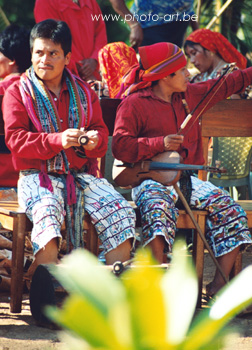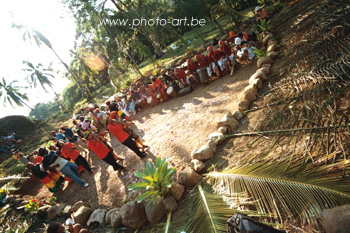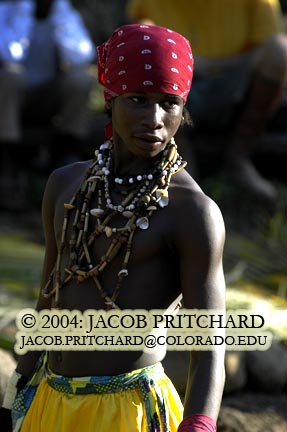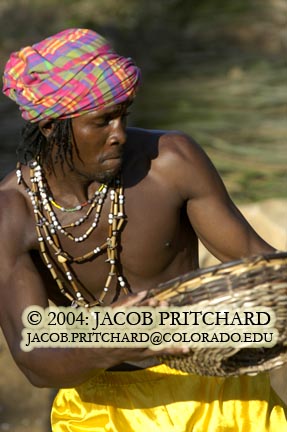March 4th 2003
From Guatemala to Panama, we can meet a mosaïque of native
peoples and tribes, isolated and mostly poor, who do not know each other.
The minorities of Central America, with their distinct traditional cultures,
have in common the marginalisation of their culture in their Central American
countries. In today's world of globalisation, all are confronted with
the permanent fight between the preservation of their traditions and the
imposing modernisation of their countries. In the context where populations
are slowly failing to remember their ancestral myths, an original pilot
project appeared. It is a French theatre group, which organised intercultural
theatre fusions between four indigenous communities of Guatemala, Honduras
and Panama. The idea of the project called "The Heart of the World"
is to create a cultural exchange juggling with the differences and similarities
of those minorities. It all happens in an imaginary space accessible to
all, theatre.
In the South West of France, they are a group of eight individuals, living
in a community for the past 15 years, in a 16th century farm surrounded
by cats and dogs. They share the same packs of cigarettes, the same bank
account. Those friends have the common passion of theatre. They call themselves
"the Babel Tower", with reference to the Bible. "Our project
is to build a tower, where languages and differences are not a setback
anymore but make the diversity of our planet," explains Frédérique
Servant, one of the founders of the Babel Tower.
Their president, Romain Pompidou, grand son of the French President, was
one of the first to contact the Mayans of Guatemala. Six years ago, a
play was presented in France and in Guatemala. Then in 2000 the project
expanded to other artistic groups in Central America, creating the first
play in Antigua, Guatemala, in 2002. The Heart of the World was born,
financed by the French government, the Honduran institute of tourism and
private companies.
The Heart of the World works today with four communities - two afro latin
(the Garifunas of Honduras and the Congos of Panama), and two native Indian
(the Maya Sutuhil of Guatemala and the Kunas of Panama).
The French group is used as a link, and organizes seminaires, intercultural festivals, finds investments, and finally leads the theatre performances. The goal is to create a network with the minorities that later on will be able to use it's potential without the help of the French organization.
Last February, in the Caribbean island of Bastimentos, in the Bocas del Toro province of Panama, the last theatre fusion was held between the communities. During a month, 47 artists lived together and performed night and day to prepare the theatre play. The final performance was played in a natural amphitheatre, in the middle of the jungle. A French Video team was present to film a documentary on the intercultural gathering. Every group was able to open up in order to spread their origins, history and actual situation.
The group of Mayans Sutuhils musicians come from Santiago Atitlan near
the Lake Atitlan of Guatemala. They are mostly introverted and calm artists.
They are very religious people, most of the time intellectualizing their
way of acting. Their music and their dance seem relatively simple. Diego
Tiney Dablo tells timidly to his brothers, "I don't know what people
can think, that it can be a very simple dance, a banal music that seems
very easy, but it is our culture. Maybe someone would say that it doesn't
have any value, but the one who presents you his culture is proud to present
it to you.
Diego has been chosen to play the role of their spiritual guide Jilakman,
the masked God to whom one makes offerings of cigarettes and alcohol.
"I am an actor of the Jilakman, sacred character that bequeathed
from our forebearers. We have a lot of respect for him because he has
a big value. I represent it so that people know that we always keep our
roots. The Jilakman is a Mayan God that has a lot of importance and significance.
Every time that I play this role, I must ask for the permission".
There is a delicate topic to approach with the Mayases - the one of the
civil War of Guatemala, 30 years of massacre between military, para-military
and guerrilleros. The Mayas Sutuhils remain still deeply traumatized by
their painful experience of the war. Their initial music group, that they
created in 1976, was a victim of persecution. "In 77, we recorded
our music for the first time" tells Diego. "Afterwards, there
was the problem of the violence. Our director was kidnapped, then my brother,
then other mates… people interpreted our music badly. Militaries,
the evangelical thought that it was a music of protest... Our music doesn't
have anything to do with the protest, it is our forebearers who bequeathed
it to us, it is a memory. We don't want that this culture goes into oblivion.
For this reason, thanks to the Jilakman, we continued to organize ourselves
after the fall of the group".
Juan Mendoza, their director, wants to forget the Civil War. "The
village of Santiago suffered a lot. It is painful for me, I cannot speak
of it, because I suffered a lot"
Agreements of peace have been signed only in 1996. Hardly a few months
ago, the old Guatemalan dictator Rio Montt, responsible for a large number
of massacres during the civil war, succeeded to counter the electoral
law to represent himself at the presidential elections
In contrast to the Mayas, the Garifunas from Honduras are not afraid to
use their voice and body to express themselves, with their art based on
improvisation and spontaneity. They dance with African influenced rhythms,
creating an amazing ambiance with their drums and voices. These black
people of Honduras are the descendents of African slaves mixed with the
Arawak native indigenous from the island of San Vicente. The Garifunas
have spread all over the Caribbean coast of Central America and gained
a distinct culture apart from the Latinos. In today's context of globalization,
this Honduran minority fears the loss of their cultural heritage. Theatre,
for them is a way to remind the world of their existence.
The Kunas Indians from Ustupu, in the Kuna Yala archipelago of Panama,
can be seen as a warrior tribe. They are one of the only indigenous people
who have fought against the army of Panama to protect their traditions
and culture, and who managed to find external help to remain an autonomous
territory. In 1925, the Kunas made a revolution and obtained a status
of political autonomy in Panama. Briseida Iglesias, a 40 year old lady,
leader of the Kuna group, tells us that before 1925, "the Americans
were studying the body of an albinos woman. They brought her to the United
States with a group of Indians so that they could ask for help to fight
the conquistadors. The Americans agreed to give them weapons, though refused
to come to fight along the Kunas." The Comarca Kuna Yala is today
autonomous, with its own laws and General Congress. They have maintained
their traditional costumes and ways of living.
Briseida Iglesias, tells us about her native tribe of Panama. "Before,
we used to live in the forest. Because of malaria epidemics, we had to
migrate to the coast. There, another sickness attacked us, but a different
kind, one that can walk, one that can think, one that kills: colonisation…
They came to mistreat our grandfathers, to rape our women, to cut our
heads. They said we were half-salvage."
"The story of our community is very sad, from the creation until
today, we have been martyred, this is why I am getting sad when I tell
how they killed our grandfathers" says this mother of six children
while wiping her tears. Briseida takes her breath by readjusting her bracelets.
Kuna women still wear their traditional cloth, and have their arms and
legs covered by multi coloured pearls. According to their beliefs, it
protects them from bad spirits.
The Kuna people are a warrior tribe where women have an important role. Briseida explains that "at the time of colonisation, the leader of the group was a woman called Narascunial, the first woman who confronted the barbarian assassinators. The community was scared. This courageous woman, along with her daughter, went to the jungle to fight the invaders. They planed their strategy during the nights. Narascunial was beautiful, with long hair down to her knees. When the colons arrived, she totally undressed herself. The invaders, impressed by her beauty, tried to get closer, but fell into the trap the women had prepared during the night. When Narascunial came back to her community, she told the men: "you are cowards, why don't you react when you see that they rape the women and kill your brothers, you have to fight!""
Still today, the Kunas can be seen as proud and independent, protecting
themselves from the influence of massive tourism. "Right now, the
Congress doesn't allow the access to the San Blas archipelago to tourist,
except if they pay an entrance fee" explains Sogui Diaz, a young
Kuna student who lives in the capital. "It is because we need to
pay many things in our community to survive. I recognize that we are a
bit closed to the external world…"
Sogui has a life very similar to most girls in the capital city. She admits
that there is a sort of "contagion" from the occidental world.
"There is no way to escape; we constantly need to fight to preserve
what is ours, our culture. I am a young girl who has been raised in the
capital, but with the internal fight to cultivate my roots."
Today, the highest percentage of poverty in Panama concerns the indigenous
tribes. The Comarca Kuna Yala is protected, thanks to its autonomous status,
but their neighbouring territory belonging to the Wounam or the Emberas
are getting smaller and smaller due to the investors.
Briseida is revolted: " I want to go to our president and tell her
out loud: "You do not recognize our culture, you do not valorise
our brothers" but when I come into politics, every one applauds because
they want my vote. It is what is going on at the moment. "According
to her, the Panama government is only interested in the destiny of the
Indians during the elections, like the ones to be organized next May,
when the four year term of the actual President Mirella Moscoso will be
over.
Also from Panama, the black community of the Congos is the newest arrival into the project. They have brought their 77 year old Queen Alejandrina for this unique theatre performance. This famous old woman, holding her huge crown proudly, is recognized in the streets by the locals who have seen her on TV. She explains that the meaning of the Congo's traditional dances comes from the time of slavery, today usually performed during the annual carnival. The princess and the prince of the Congos also honoured the project by participating in the play.
In the play, each has accepted to sacrifice a little bit of their vision
of the world to integrate the other's.
What unites those four communities is the belief in magic, spells, and
the cult of their ancestors. In each culture, we find the concept of secret
rituals. For the Mayans, it is indiscreet to ask information about the
great Jilakman. "If someone wants to know, he has to go through the
same path that we did" says Juan Mendoza. "It is like when someone
is hungry, it would be too easy to have right away a meal served for you,
no, he has to fight like we did!"
For the Kunas as well, there are taboo subjects, such as "Mother
Earth". It is forbidden to bring this subject in the dances and songs,
otherwise "you can become blind or mute, you will feel like vomiting
in front of the public!" explains Briceida.
The Queen of the Congos publicly declared, the day of her arrival, she
would rather die than reveal certain ancestral secrets to anyone else
but the Prince and the Princess.
On their part, the Garifunas have asked the permission of their priest
Bouye in their village for acting some scenes. "If we sing sacred
songs, we can fall, and no one will heal us. The spirits and the demons
will come, not only on us, but on everyone in the theatre" says Neta,
the Garifuna coordinator.
Anne Sylvie Mayza-Badré, the French artistic director explains that they " had to make them understand that theatre is not a way to present ritual as they really are in sacred ceremonies, but that theatre can just be inspired by rituals. In no means it is a real ritual presented for the public, but a fiction that has been elaborated. We don't have to reveal anyone's secrets."
Artistically, the community participants in the project are very complementary. The French bring their "savoir faire" (know how), they are the ones organizing the meetings and coordinating the plays. The Mayans respect everyone's speaking time and never complain about the difficult conditions after long hours of practice in the heat. The Garifunas are very spontaneous and are used to improvising. But along with the Congos, they are quite undisciplined and have concentration problems. The Congos have nevertheless the custom to play in front of a public, presenting dances every year during the Carnival. However, the royal family of the Congos now lives in the capital city's ghettos and their culture based on hierarchy seems to be questioned by the younger of the group who keep on disobeying. During the practice time, the Kunas were there to show the example of calm and discipline with their sense of organization and their art very structured. With their character of old warriors, even the youngest Kuna girls, intimidated during the final presentation, had splendid smiles on their face.
The French artistic director has chosen the dream as the main theme of the theatre presentation on February 26th. "It is a subject that gathers the four communities, their mythologies, the visible, and the invisible, the ancestors." explains Anne Sylvie Mayza-Badré. Typically worldwide, dreams are important, however, in the occidental world, we tend to not redeem them with value. For the Mayans, Kunas, Garifunas and, Congos, a dream is very symbolic towards reality. It is not "just a dream". For the actors, the dream allows them to jump from one element to another, with different scenes in their history and religion."
The actors chose themselves the title of the play " El Sueño de las raíces profundas " (The dream of the deep roots). Sogui Diaz was the main actress. She is a 26 year old Kuna woman living in Panama city, where she has a life similar to most girls in the capital city. "I am a young girl who has been raised in the capital, but with the internal fight to cultivate my roots" she argues. Sogui speaks fluently Kuna, participates in traditional dances and collects Molas, their typical traditional cloth. By participating in the representations and getting involved in politics in the General Congress she intends to "save" the younger generations. "They live in a modern world, but they can also combine it with the traditional world. Like me for example! In the play, I represent a modern girl who doesn't really identify herself with any culture. I submerge myself in the world of dreams, a world crazy of adventure where I learn knowing cultures of Central America. Many people do not know anything about the Kunas, including people living in Panama!".
The final representation was shown on the hill above the village of the Island of Bastimentos, in a natural amphitheatre created for the occasion in the middle of the splendid tropical vegetation of the island. All the kids of the village were present on the day of the big show. We could count a hundred foreigners, all enchanted by this exceptional opportunity. "Being able to watch this play was a very surprising and colourful experience. Seeing those four communities unified for this cultural event was a magical experience. The fusion of songs and dances was just the best way to externalise their cultural differences. The result was splendid and fascinating. The miscegenation of the four minorities is a jewel of colors and smiles. I really hope they will be able to play in Europe and other Latin-American countries and show openness to people", explained Anthony Asael, a lucky Belgian photographer present that day.
A French video team filmed the intercultural gathering during the entire month of the practice. "Theatre is an ephemeral art and once the performance is played, everything is over" admits Romain Pompidou. " The goal of this activity was to have a video testimony of quality in order to show the play and everything around it". The journalist and camera making the documentary filmed the event, the moments of break, concentration or tension, and gave the opportunity to each group participating in the project to tell about their culture. The team will have no problem of finding a production company considering the importance of the intercultural fusion.
The Project " The Heart of the World " doesn't stop here. Next year, a "tournée" (tour) is planed in the capitals of Central America, after the creation of another play with this time, the integration of French actors. In 2006, the best actors of the group will travel to Europe to play in France and in Spain. We are not done hearing about The Heart of the World.
At the end of the theatre presentation, the main actress woke up in the same world of noise and movements where she had fallen asleep. However she now owns a "little extra" that she shares with others. The circle is buckled. The French, Kunas, Congos, Garifunas and Mayan actors, dancers, musicians, organisers and observers, along with every spectator, all left as well the little paradise island of Bastimentos with a "little extra."



Photos Jake Pritchard














